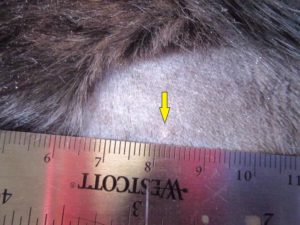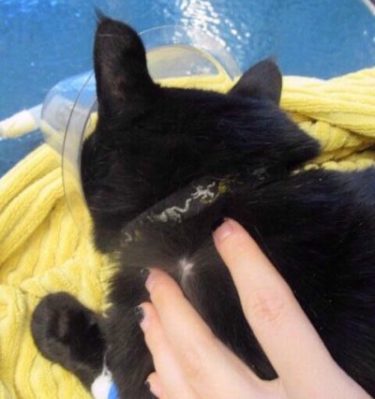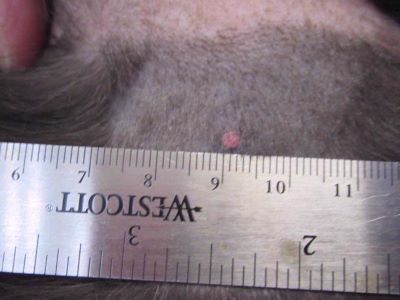
Often, we see our dog and cat patients for one issue, and during our physical exam, we uncover other potential problems. Some health changes are more easily noticed by you as a pet owner – vomiting, limping, coughing, eye discharge, and tartar on the teeth. Other changes may not be visible – a heart murmur – or may look insignificant, especially if your pet isn’t bothered by something. This is why exams are so important. Diagnosing medical conditions early gives you and your pet more options for treatment, and frequently a better outcome.
Smootlet is a lovely, almost 11-year-old black kitty with bright green eyes. At a recent visit for a nail issue, a small skin nodule was found on the left side of her neck. The tissue was slightly raised and a little pink. From the picture you can see this tissue on the left side of Smootlet’s neck, was quite small.
Dr. Ravneet Kaur addressed the ingrown nail and advised the owner about doing a fine needle aspirate for the skin growth. We use a small needle inserted into the tissue to collect some of the cells, then send the slides to a veterinary pathologist which can help get a definitive diagnosis. Some tissues readily release cells so we are certain about the type of growth; other times we get blood cells and tissue cells but not enough to be clear cut, but the information is still helpful.
There are a variety of common skin growths that cats and dogs can develop. Some growths are almost always non-cancerous, others are quite serious, and some that are technically a type of cancer, can behave as a benign growth. Knowing what something is will also help answer the question of ‘what should we do?’
-
- Papilloma or skin wart
- Sebaceous adenoma
- Benign Sebaceous Gland tumor
- Skin tag
- Scar
- Cyst
- Lipoma
- Histiocytoma
- Lipoma
- Mast Cell tumor
- Cutaneous Lymphoma
- Dermal Hemangiosarcoma
- Melanocytoma vs Malignant Melanoma
The FNA of Smootlet’s skin growth confirmed this was a Mast Cell Tumor (MCT). These are considered a type of cancer, however, in cats when the growths are only present in the skin and they are solitary or just a couple, they most often behave in a benign fashion. We elected to plan surgical removal at the same time as Smootlet was scheduled to have her teeth cleaned under anesthesia. We did a thorough body evaluation for other nodules and found another tiny growth on her left shoulder.
 See the picture to the left; the growth is barely visible and could be easily missed. The small white spot was barely raised; the appearance of this growth varies from the other confirmed mast cell tumor that we found on Smootlet’s neck.
See the picture to the left; the growth is barely visible and could be easily missed. The small white spot was barely raised; the appearance of this growth varies from the other confirmed mast cell tumor that we found on Smootlet’s neck.
Both tissues were removed and submitted for histopathology – both growths were confirmed to be MCTs. Fortunately for Smootlet, the were classified as low-grade and her prognosis is considered good. We will continue to monitor for additional skin nodules as we know that some cats can have additional tumors develop over time.
We encourage you to be in the habit of checking your pet’s skin on a regular basis. The fur of pets can hide skin changes and can make it hard to find something when it first appears. Use the tips of your fingers to get down below the fur and check all the nooks and crannies. You may not know what you are feeling, but doing this consistently helps you notice differences and bring it to your veterinarian’s attention.
When evaluating any skin change, veterinarians will advise you on the next steps. Skin scrapes, cytology, and fine needle aspirates can all be helpful. Smaller tissue growths are hard to sample, but they are more easily removed, especially when located in certain body areas. Surgery and histopathology can give definitive answers. If you find skin growths on your cat or dog that have not been evaluated, mark the location so that it is easy to find again, and make an appointment with your veterinarian.



